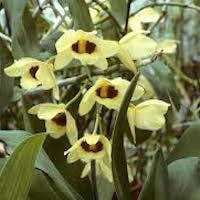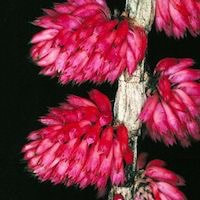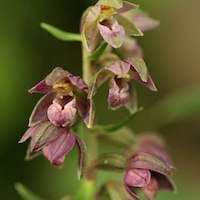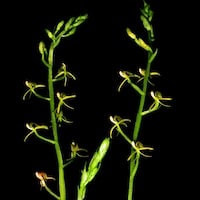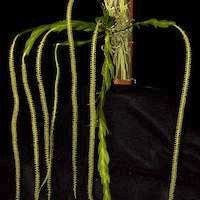WC7 - Women's Citrus 7 - Fruit sensation
|
Native Singaporean Orchid notes: Vanda Tessellata
This Vanda orchid species, possibly originating from India or the IndoChina region, is known for its distinctive semi-terete leaves and smaller stature compared to other vandas. Its flowers are notable for their tan-brown petals, sepals, and a purple lip, emitting a sweet-citrus fragrance with hints of s'mores. Blooming from summer through early winter, it releases a captivating floral scent enriched with Mulberry and guava notes. Revered in traditional Asian medicine as Rasna/Rasya, it contains various beneficial compounds like alkaloids and saponins. Studies suggest it may help manage blood pressure, promote wound healing, and exhibit anti-arthritic properties, adding to its historical and medicinal significance.
|
Therapeutic Orchid notes:
|
Dendrobium pulchellum Roxb. ex Lindl.
This Dendrobium orchid, known as Uang Chang Nao and Uang Kham Ta Kwai in Thailand, and Hoang thao, Po len, Co anh in Vietnam, is widely distributed from the eastern Himalaya to Bangladesh, Myanmar, Thailand, Indochina, and Peninsular Malaysia. It contains bibenzyl compounds that have shown promise in promoting cell death in lung cancer by preventing cells from attaching to the extracellular matrix. These compounds also exhibit inhibitory effects on the growth of lung cancer cells. In traditional medicine, particularly among Chinese communities in Indochina and Vietnam, it is utilized under the name "shihu," highlighting its enduring role in herbal remedies and health practices. |
|
Dendrobium purpureum Roxb.
Dendrobium purpureum Roxb., also known as Angrec cassomba, blooms from June to October, which coincides with the driest part of the year. In traditional medicine in Amboin (Sulawesi), the heated pulp from crushed orchid stems is applied as a poultice to treat whitlow. This practice, recorded by Rumphius in the late seventeenth century, highlights the orchid's practical use in local healing traditions. |
|
Epipactis helleborine, var. helleborine syn. Epipactis teneii Schltr.
Known as Huiyanhuoshao Lan or Huoshao Lan, this orchid thrives in Europe, Pakistan, and Nepal. It grows abundantly in temperate regions of the northern hemisphere, including Yunnan, and is highly valued for its medicinal properties. In Traditional Chinese Medicine (TCM), it is primarily used as a tonic. The entire plant is utilized to cool the lungs and liver, alleviate coughs and phlegm, promote blood circulation, relieve toothaches, treat diarrhea and back pain, and is even reputed to counteract snake bites. In Nepal, the roots are processed to extract juice used for treating conditions such as insanity and gout. |
|
Liparis bootanensis Griff. Syn. Liparis plicata Franch & Savat.
Jiuliandeng, an epiphytic or lithophytic herb with small, clustered, ovoid pseudobulbs, is native to regions spanning Nepal to southern China, including Hainan, Taiwan, and various Southeast Asian countries. In Chinese Traditional Medicine (CTM), the entire plant is utilized for its medicinal benefits. It is known to treat fever, boost qi and blood circulation, address tuberculosis and associated lymph node swelling, heal sores and ulcers, relieve abdominal pain and bloating, and combat schistosomiasis. Additionally, when cooked with pork, it is used to alleviate coughs and sore throats, highlighting its diverse applications in traditional healing practices. |
|
Oberonia lycopodioides (J.Koenig) Ormerod Syn. Oberonia anceps Lindl.
Known as Sakat lidah buaya in Malay, this species thrives in sunny lowland areas and is commonly found throughout Indochina, Thailand, Sumatra, Malaysia, Kalimantan, the Philippines, and Sulawesi. It's a miniature plant that grows abundantly in these regions. In traditional herbal practices of Malaysia, the pulverized Sakat lidah buaya plant is used as a poultice to effectively treat boils and infected wounds. This application reflects its local reputation for treating skin ailments, providing a natural remedy that has been valued and utilized for its healing properties. |
Other scent note
Top of Bright citrus notes, Mirabelle, tangerine, fresh cherry, tangy mango, ripe peach, strawberry, hints of spice & green apple
Scentopia Library Reference ingredient
Apricot - Check details at Scentopia's scent library
Download the guided mediation that works best with this Orchid fragrance oil
| women_citrus_essential_oil_orchi_00007.mp3 | |
| File Size: | 172472 kb |
| File Type: | mp3 |

